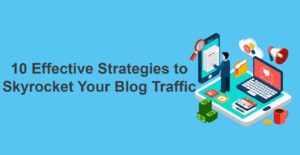Social media isn’t just for sharing cat videos and vacation snapshots – it’s a powerful tool that can skyrocket your brand awareness and help you engage with your target audience like never before. Buckle up as we take a deep dive into some savvy social media strategies specifically tailored for small businesses.
Consistency, authenticity, and adaptability are your best friends. As you implement these strategies, keep experimenting, learning, and adapting to the ever-changing landscape of social media. To unleash your brand on the digital stage, and watch your small business flourish like never before follow these Social Media Strategies for Small Businesses.
Understanding Social Media for Small Businesses
Before we dive into the exciting world of strategies, let’s get a grip on what social media is all about for small businesses. Think of social media platforms as your virtual storefronts where you can showcase your products, share your brand story, and engage with your customers in real-time. But here’s the catch – not all platforms are created equal. It’s crucial to choose the ones that align with your business goals and resonate with your audience.
Picking the Perfect Platforms
Audience Insight: Get to know your target audience – their preferences, habits, and where they hang out online. This insight will guide you towards the platforms that matter most to them.
Platform Perks: Each platform offers unique features. Whether it’s the visual appeal of Instagram or the professional vibe of LinkedIn, pick platforms that match your brand’s personality.
Quality over Quantity: Don’t spread yourself thin across every platform out there. Focus on the ones that let you shine, consistently.
How businesses use social media for marketing
Social media has become an integral part of modern marketing strategies, offering businesses a powerful platform to connect with their target audience, build brand awareness, drive engagement, and, ultimately, increase sales and revenue.
Businesses use social media for marketing to connect with their audience, build brand recognition, engage with customers, promote products and services, gather valuable insights, and adapt to the ever-evolving digital landscape.
An effective social media strategy is essential for modern businesses to thrive online.
Here’s a detailed explanation of how businesses use social media for marketing:
Establishing a Strong Online Presence:
Businesses create and maintain profiles on popular social media platforms like Facebook, Instagram, Twitter, and LinkedIn. These profiles serve as digital storefronts, providing essential information about the company, products, and services.
Building Brand Awareness:
Regularly posting relevant content helps businesses raise brand awareness. They share their brand’s values, mission, and culture through posts, images, and videos. Consistency in branding across platforms is crucial for a unified brand image.
Engaging with the Audience:
Social media provides a direct line of communication with customers. Businesses engage with their audience by responding to comments, messages, and feedback. This engagement fosters a sense of community and loyalty.
Customer Feedback and Market Research:
Social media is an invaluable source of feedback and market research. Businesses can use comments, reviews, and polls to gather insights into customer preferences, pain points, and trends.
Community Building:
Many businesses create groups or communities within social media platforms where customers can connect, ask questions, and share experiences. These communities can foster a sense of belonging and brand loyalty.
Impact of social media on business
The impact of social media on business is profound and multifaceted. Social media has transformed how companies operate, communicate, and market their products or services.
Social media has revolutionized the way businesses operate and market themselves. It can impact every facet of an organization, from brand development to customer service, market research, and even corporate culture. Businesses that effectively harness social media’s power can gain a competitive edge and thrive in the digital age.
How can social media help a business grow
Social media can play a pivotal role in helping a business grow in numerous ways. Social media can be a dynamic tool for achieving various business goals when used effectively.
Here’s a detailed explanation of how social media can help a business grow:
Lead Generation and Sales:
Social media platforms offer various methods to generate leads and drive sales. Features like direct messaging and shopping options enable businesses to convert social media users into customers.
Global Reach and Expansion:
Social media transcends geographical boundaries, allowing businesses to reach a global audience. This benefits companies looking to expand internationally or export their products and services.
How to create social media posts for Your Business
Creating engaging social media posts for small businesses means developing content for social media platforms that captures the audience’s attention, encourages interaction, and serves small businesses’ specific needs and goals.
These posts should be designed to attract and retain customers, drive brand awareness, and ultimately contribute to the growth and success of a small business in the digital realm.
Now that you’ve chosen your platforms, let’s talk about the heart of social media – content! Your posts should be the perfect blend of engaging, valuable, and authentic to your brand.
Defining Your Brand Voice
Consistency is Key: Develop a consistent brand voice across all platforms. Whether it’s witty, educational, or warm – stick to your tone.
Storytelling Magic: Use your posts to narrate the story behind your products or services. People love connecting with the human side of your brand.
Educate and Entertain: Balance your content mix with informative posts and entertaining anecdotes. Keep your audience engaged with a variety of content.
Visuals Speak Volumes
Visual Feast: Invest in high-quality images that showcase your offerings in the best light possible.
Video Stars: Leverage the power of short videos to demonstrate product usage, share behind-the-scenes snippets, or provide helpful how-to guides.
Infographics FTW: Summarize valuable information in easily digestible infographics that your audience can’t resist sharing.
Steps to Create social media posts for businesses
Creating effective social media posts for businesses requires a thoughtful and strategic approach.
To help you craft unique and engaging posts, here are the steps broken down in detail:
Define Your Goals and Audience:
Before you start creating posts, establish clear objectives. Are you aiming to increase brand awareness, drive sales, engage your audience, or something else? Identify your target audience and their preferences, interests, and pain points. Understanding your goals and audience will inform your content strategy.
Choose the Right Platforms:
Only some social media platforms are suitable for some businesses. Select the platforms where your target audience is most active. Each platform has its own demographics and content formats. For example, Instagram is visual, Twitter is text-heavy, and LinkedIn is professional. Choose platforms that align with your brand and objectives.
Understand Content Types:
Diversify your content to keep your audience engaged. Common content types include:
Text Posts: Share updates, tips, or thought-provoking questions.
Visual Content: Post images, infographics, or memes that are relevant to your brand.
Video Content: Create short videos, product demos, or behind-the-scenes clips.
User-Generated Content: Encourage customers to share their experiences with your products or services.
Stories: Utilize the “Stories” feature on platforms like Instagram and Facebook for ephemeral content.
Craft Captivating Headlines and Captions:
Your headlines and captions should be attention-grabbing. Use clear and concise language, and consider using humor, storytelling, or posing questions to engage the reader. Remember to include relevant hashtags to increase discoverability.
Create High-Quality Visuals:
Visual content is highly shareable and memorable. Invest in high-quality images and graphics. Use professional tools or apps for image editing and ensure your visuals align with your brand’s aesthetics.
Engaging for Success: Building Meaningful Connections
Social media isn’t a one-way street; it’s a platform for conversations, connections, and community-building. Here’s how to keep the engagement flowing.
Respond and Connect
Timely Replies: Respond promptly to comments, messages, and mentions. Show that you’re actively listening and valuing their input.
Ask Away: Throw questions into the mix to ignite conversations and understand your audience better.
Gratitude Matters: Express gratitude for your followers’ support, celebrate milestones, and show that you genuinely care.
Embrace User-Generated Content (UGC)
Share the Spotlight: Encourage your customers to share their experiences with your products. This not only adds authenticity but also builds trust.
Showcase Your Fans: Feature user-generated content on your page. It’s a fantastic way to celebrate your customers and foster a sense of community.
Hashtags: Your Social Media Sidekicks
Hashtags are like magic spells for social media. They boost your post’s visibility and help users discover your content.
The Art of Hashtags
Relevant Hashtags: Research industry-specific and trending hashtags that fit your content like a glove.
Create Your Brand Magic: Develop your branded hashtag that’s unique to your business. Encourage your followers to use it to join the conversation.
Hashtag Etiquette
Quality over Quantity: Avoid hashtag stuffing. Choose a few meaningful hashtags instead of bombarding your posts with too many.
Stay Trendy: Keep an eye on trending hashtags, but only jump on board if they genuinely align with your content.
Social Media Advertising
Paid Promotion for a Wider Reach
While organic reach is fantastic, sometimes you need a little boost to reach a broader audience. This is where social media advertising comes into play.
Clear Objectives Rule
Define Your Goals: Whether it’s driving traffic, boosting sales, or enhancing brand awareness – your objectives will shape your ad strategy.
Laser-Focused Targeting: Utilize platforms’ targeting options to reach the audience that matters most to your business.
Captivating Ad Creatives
Visuals that Pop: Use captivating visuals that grab attention, even in a sea of scrolling.
Compelling Copy: Craft concise and compelling ad copy that gets your message across effectively.
Experiment and Learn
A/B Testing: Create variations of your ads to see what resonates best. Use the insights to fine-tune your ad strategy.
Measuring Your Social Media Impact:
Analyze Your Social Media Impact
Your hard work deserves recognition. Dive into analytics to understand what’s working and what needs a tweak.
Analytics Essentials
Platform Insights: Make the most of built-in analytics tools offered by social media platforms.
Google Analytics Integration: For website traffic, integrate Google Analytics to track conversions, engagement, and more.
Key Metrics to Watch
Engagement Rate: Monitor likes, comments, and shares. It reflects how well your content resonates with your audience.
Click-Through Rate (CTR): If you’re running ads, track CTR to evaluate the effectiveness of your ad strategy.
Evolution through Insights
Learn and Adapt: Regularly analyze your data to identify trends and areas for improvement. Your strategy should evolve based on insights.
Collaborating with Influencers
Influencers Marketing Strategy for Your Small Business
Influencer collaborations aren’t just for the big brands. Small businesses can benefit immensely by teaming up with influencers.
Finding Your Fit
Relevance Matters: Identify influencers whose audience aligns with your target demographic.
Engagement Check: Look beyond follower count – genuine engagement and authenticity are crucial.
Authentic Partnerships
Mutual Benefits: Approach influencers with a mutually beneficial mindset. How can both parties win from this collaboration?
Content Co-Creation: Collaborate on content that resonates with both your audiences. Authenticity is key.
Measure the Impact
ROI Tracking: Monitor engagement, website traffic, and sales generated through influencer collaborations.
Assessing Results: Evaluate whether the collaboration met your objectives and contributed to your business growth.





